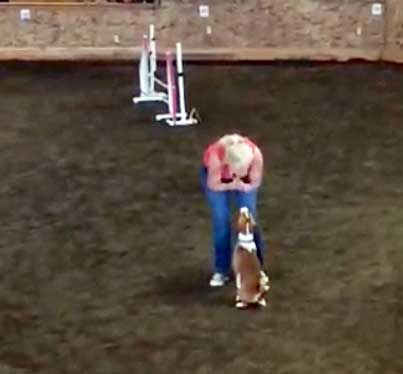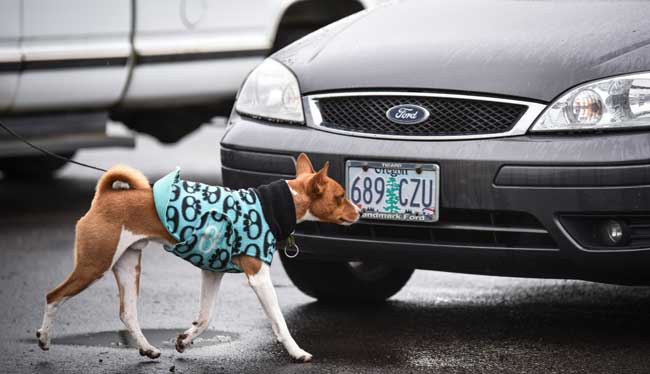The Rip Van Wrinkler, XXIII, Issue 2, May 2019
Page 8 <previous page> <next page>
Training Conversation
1. MACH4 Zuri.
1. PACH Oakley.
3. Katie Campbell & Chief jump into agility.
4. Ninja agility first in Finland
5. NW2 Turkish does Nosework.
6. Loose Leash Walking.
CONGRATULATIONS TO MACH4!ZURI!

MACH4 Fly’n Hi’s Pretty Amazing and Paul Mount. Zuri is First MACH4 Basenji.
CONGRATULATIONS TO PACH OAKLEY!

PACH Jasiri-Sukari Bronco Busting Annie RN CAA SC MXP7 MXPS MJP4 MJPB TKP NDD NBDD VB (VBE pending).
CONGRATULATIONS TO NINJA IN FINLAD!

So Ninja, AJIBU FOOLISH HEART, is now first basenji in Finland who has achieved agility certificate in medi 3 class, propably only one in Europe. She has also obtained two times the needed results to have a permission to entry to the Finnish Championships.
Team Chief!
Katie Campbell and Chief had their first weekend of agillity competitipn and this is what they did!

Two ACT1 tests; Two perfect scores of 100; First test 2nd place in his 16" division; Second test FIRST place in his 16" division (I think 34 entries per test, with 12 in his 16" division). And his run time was 1/2 second faster in the second course than the first at 28 seconds.

First Leg: https://www.youtube.com/watch?v=Ti889-sIeoE&feature=youtu.be
Second/final Leg: https://www.youtube.com/watch?v=RVnrrwKiEGs&feature=youtu.be
 Back cross!!!!
Back cross!!!!
Chief is a very good boy and unusually biddable. Our first agility instructor picked him out as an excellent prospect when he was young, and I knew NOTHING about agility and hadn't finished him in conformation yet. But... now here we are.
The judge came up to me after his runs and literally gushed over Chief (it was nearly embarrassing) in front of doG and everyone. He was so complimentary of our teamwork and how agile Chief is. I'm just so proud to be able to do this with "a Basenji"... and we both have a lot of fun doing it.

NW2 Turkish!
 Checking. Nope - not here.
Checking. Nope - not here.

Mom - come on . . .

FOUND IT!!!!!
Loose Leash Walking: Easier with Horses Than Dogs?
by Suzanne Clothier (link)

Horse and woman walking together on loose lead
Why do horses need fewer reminders than dogs for loose leash walking? It would seem that teaching a 1000 pound horse to walk politely should be far more difficult than working with a 60 pound dog. And yet, the truth is that it’s far easier to have a horse on a loose leash while walking. Why? In all cases, both bio-mechanics and gait are involved.
Relaxed horse typically moves from point A to point B at a walk.
Humans typically move from point A to point B at a walk.
Horse + human – both are in the same gait: walk. Change of speed up or down in that same gait easily accommodated with adjustment in stride length (or tempo, or both).
Relaxed dogs typically move from point A to point B at a trot (especially if “going somewhere” – even if that’s from the kitchen to the hallway!)
Dog + human – both are in different gaits. Most dogs cannot trot as slowly as the typical person walks. (Amazingly, many horses can and do trot as slowly as a human walks!)
Think of the gaits as gears. You can only be in one at a time. If you’ve ever driven a stick shift/manual drive car or ridden a 10-speed bicycle, the problem is obvious. If you’re in first gear and the dog is in second gear or even third gear, there is a complete mismatch that is never resolved by treats or leash pops, equipment that squeezes the dog’s shoulders or ribcage (even when marketed as humane!), or head halters.
Some dogs can make the adjustment, match the handler and no one even notices or gives the dog credit for this accommodation. The ability to match the handler’s speed has nothing to do with dog’s size. It does have to do with conformation & working style, and of course cooperation by the dog. In this same way a very tall person will alter their speed to move in sync with a shorter or slower moving person.
My 36″ tall Scottish Deerhound could trot almost in place, even when I slowed to a slow heel in obedience work, while my 24″ GSD really struggled to stay in heel at a trot unless I was really moving fast at a walk. She never had a problem if I jogged. She easily nailed the fast and slow in heeling, but working well together at “normal” speed was on me to make it right for her. I took very quick small steps so that I offered her a speed that was comfortable for her to trot beside me.
Worse for our dogs, humans are not consistent movers unless they learn to be as a part of a team. It’s like driving behind someone in a automatic who slows just enough to make you downshift but you’re winding out at that lower gear but going too slow to upshift—and doing it every few steps!
This mismatch disappears quickly if the one or the other (dog or human) speeds up or slows down. Generally speaking, dogs out jogging or biking or scooting with a person are *not* pulling! but typically trotting along nicely because the handler & dog are in the same gear. In obedience/rally work, the mismatch causes lagging & forging which is blamed on the dog, though the truth is the handler is responsible for finding the working speed where the dog can work comfortably to move with the handler, not ahead or behind.
Watch really skilled obedience/ringwork competitors working their dogs, and they are *moving!* while heeling, and for good reason. Anyone who tells me their dog forges or lags will find me adjusting them, not the dog. Breed ring handlers must find the speed that shows their dog to his best advantage. Too slow and the dog walks or paces, too fast and the dog begins to canter.
In guide dog work, the dog’s native speed matters a great deal. If the person being guided is poorly matched with the dog, the dog will either be forced to work in an intermediate gait (like the pace, which is a bad idea for so many reasons), or will have difficulty consistently stepping up into the harness. Many guide schools use GPS to determine a dog’s speed in harness and match with handler accordingly.
Dogs can and do learn to walk with people at any speed. But there are biomechanical realities that inexplicably are not addressed by many trainers, while the poor dogs are the target of training, equipment and approaches all intended to fix *them.* View the dog and handler as a team who inextricably influence each other in countless ways, including just pure physical movement. Training becomes more effective when awareness of the mismatch helps to inform the solution.
For what it’s worth, a horse whose handler keeps tension on the lead will also pull, just as a dog pulls against a pulling handler who maintains leash tension. For both animals, regardless of their size or gait, it is the handler’s responsibility to work with the animal and keep softness in the lead.
